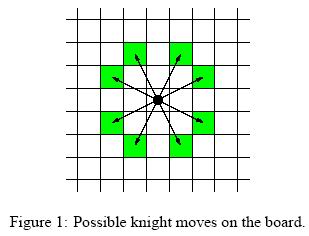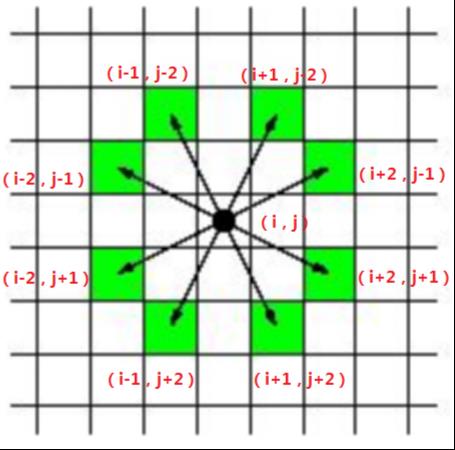POJ 1915 Knight Moves [BFS]
Posted FTA_Macro
tags:
篇首语:本文由小常识网(cha138.com)小编为大家整理,主要介绍了POJ 1915 Knight Moves [BFS]相关的知识,希望对你有一定的参考价值。
Knight Moves
| Time Limit: 1000MS | Memory Limit: 30000K | |
| Total Submissions: 26844 | Accepted: 12663 |
Description
Background Mr Somurolov, fabulous chess-gamer indeed, asserts that no one else but him can move knights from one position to another so fast. Can you beat him? The Problem Your task is to write a program to calculate the minimum number of moves needed for a knight to reach one point from another, so that you have the chance to be faster than Somurolov. For people not familiar with chess, the possible knight moves are shown in Figure 1. 

Input
The input begins with the number n of scenarios on a single line by itself. Next follow n scenarios. Each scenario consists of three lines containing integer numbers. The first line specifies the length l of a side of the chess board (4 <= l <= 300). The entire board has size l * l. The second and third line contain pair of integers {0, ..., l-1}*{0, ..., l-1} specifying the starting and ending position of the knight on the board. The integers are separated by a single blank. You can assume that the positions are valid positions on the chess board of that scenario.
Output
For each scenario of the input you have to calculate the minimal amount of knight moves which are necessary to move from the starting point to the ending point. If starting point and ending point are equal,distance is zero. The distance must be written on a single line.
Sample Input
3 8 0 0 7 0 100 0 0 30 50 10 1 1 1 1
Sample Output
5 28 0
Source
TUD Programming Contest 2001, Darmstadt, Germany
题目大意:题目讲了knight的走法(和象棋中马一样),一共有八个方向可以走。给定棋盘的大小,knight的初始坐标和所要到达的终点坐标,求出knight所需要的最小步数。
大致思路:经典的bfs,通常用队列(先进先出,FIFO)实现
初始化队列Q. Q={起点s};
标记s为己访问;
while (Q非空)
{
取Q队首元素u; u出队; if (u == 目标状态)
{…}
所有与u相邻且未被访问的点进入队列; 标记u为已访问;
}

用bfs从起始点每次遍历八个方向到终点结束,详见代码。
#include<iostream> #include<cstdio> #include<algorithm> #include<math.h> #include<queue> #include<cstring> using namespace std; int n,sx,sy,tx,ty; int m[305][305]; struct pos//定义一个结构体包含坐标和步数 { int x; int y; int num; }; int d[8][2]={-2,1,-1,2,1,2,2,1,2,-1,1,-2,-1,-2,-2,-1};//knight可以走八个方向 void bfs(int x,int y) { pos a,b; queue<pos> q; a.x=x; a.y=y; a.num=0; memset(m,0,sizeof(m)); m[a.x][a.y]=1;//把起始点标记为走过,记为1 q.push(a);//起点入队 while(!q.empty())//当队列不为空 { a=q.front();//取队列中第一个元素 q.pop();//当前第一个元素出队 if(a.x==tx&&a.y==ty)//如果到终点了 输出步数 { cout<<a.num<<endl; return; } for(int i=0;i<8;i++)//遍历8个方向 { if(a.x+d[i][0]>=0&&a.x+d[i][0]<n&&a.y+d[i][1]>=0&&a.y+d[i][1]<n&&!m[a.x+d[i][0]][a.y+d[i][1]])
//判断是否越界和走过 { b.x=a.x+d[i][0];//下一个节点的x坐标 b.y=a.y+d[i][1];//下一个节点的y坐标 b.num=a.num+1;//步数+1 m[b.x][b.y]=1;//标记走过 q.push(b);//扩展的新节点入队 } } } } int main() { int T; cin>>T; while(T--) { cin>>n; cin>>sx>>sy; cin>>tx>>ty; bfs(sx,sy); } return 0; }
以上是关于POJ 1915 Knight Moves [BFS]的主要内容,如果未能解决你的问题,请参考以下文章